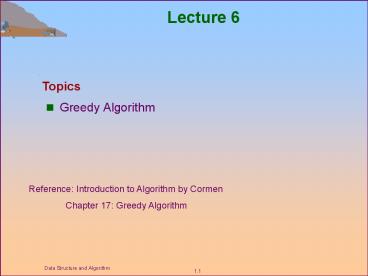Greedy Algorithm - PowerPoint PPT Presentation
1 / 11
Title:
Greedy Algorithm
Description:
Algorithm for optimization problems typically go through a sequence of steps, ... A problem exhibits optimal substructure if an optimal solution to the problem ... – PowerPoint PPT presentation
Number of Views:189
Avg rating:3.0/5.0
Title: Greedy Algorithm
1
Lecture 6
Topics
- Greedy Algorithm
Reference Introduction to Algorithm by
Cormen Chapter 17 Greedy Algorithm
2
Greedy Algorithm
- Algorithm for optimization problems typically go
through a sequence of steps, with a set of
choices at each step. - For many optimization problems, greedy algorithm
can be used. (not always) - Greedy algorithm always makes the choice that
looks best at the moment. - It makes a locally optimal choice in the hope
that this choice will lead to a globally optimal
solution. - Example
- Activity Selection Problem
- Dijkstras Shortest Path Problem
- Minimum Spanning Tree Problem
3
Activity Selection Problem
- Definition Scheduling a resource among several
competing activities. - Elaboration Suppose we have a set S 1,2,,n
of n proposed activities that wish to use a
resource, such as a lecture hall, which can be
used by only one activity at a time. Each
activity i has a start time si and finish time fi
where silt fi. - Compatibility Activities i and j are compatible
if the interval si, fi) and - sj, fj) do not overlap (i.e. sigt fj or
sjgt fi ) - Goal To select a maximum- size set of mutually
compatible activities.
4
Activity Selection Problem (Cont.)
- Assume that Input activities are sorted by
increasing finishing time. complexity O(nlg2n)
- s and f are starting and finishing time array
respectively - Activity_Selector (s, f)
ComplexityO(n) - n length(s)
- A 1
- j 1
- for i 2 to n do
- if si gt fj then
- A A U i
- j i
- return A
5
Activity Selection Problem (Cont.)
- The next selected activity is always the one
with the earliest finish time that can be legally
scheduled. - The activity picked is thus a greedy choice in
the sense that it leaves as much opportunity as
possible for the remaining activities to be
scheduled. - That is, the greedy choice is the one that
maximizes the amount of unscheduled time
remaining.
6
Elements of the Greedy Strategy
- A greedy algorithm obtains an optimal solution by
making a sequence of choices. - The choice that seems best at the moment is
chosen. - This strategy does not always produces an optimal
solution. - Then how can one tell if a greedy algorithm will
solve a particular optimization problem??
7
Elements of the Greedy Strategy (Cont.)
- How can one tell if a greedy algorithm will solve
a particular optimization problem?? - There is no way in general. But there are 2
ingredients exhibited by most greedy problems - Greedy Choice Property
- Optimal Sub Structure
8
Greedy Choice Property
- A globally optimal solution can be arrived at by
making a locally optimal (Greedy) choice. - We make whatever choice seems best at the moment
and then solve the sub problems arising after the
choice is made. - The choice made by a greedy algorithm may depend
on choices so far, by it cannot depend on any
future choices or on the solutions to sub
problems. - Thus, a greedy strategy usually progresses in a
top-down fashion, making one greedy choice after
another, iteratively reducing each given problem
instance to a smaller one.
9
Optimal Sub Structure
- A problem exhibits optimal substructure if an
optimal solution to the problem contains (within
it) optimal solution to sub problems. - In Activity Selection Problem, an optimal
solution A begins with activity 1, then the set
of activities A A 1 is an optimal solution
to the activity selection problem - S i S sigt f1
10
Knapsack Problem (Fractional)
- We are given n objects and a knapsack.
- Object i has a weight wi and the knapsack has a
capacity M. - If a fraction xi, 0lt xi lt1 of object i is
placed into the knapsack then a profit of pixi is
earned. - The objective is to obtain a filling of the
knapsack that maximize the total profit earned. - Maximize ? pixi 1lt i
lt n - subject to ? wixi lt M 1lt i lt n
11
Knapsack Problem (Fractional)
- P profit array of the objects, W weight
array of the objects, X Object Array,
nnumber of objects, - M knapsack capacity
- objects are ordered so that P(i)/W(i) gt
P(i1)/W(i1) - Knapsack(M, n)
Complexity O(n) - X 0 //initialize object vector (array)
- cu M //remaining knapsack capacity
- for i 1 to n do
- if W(i) gtcu then
- Exit
- X(i) 1
- cu cu W(i)
- if iltn then
- X(i) cu/W(i)































